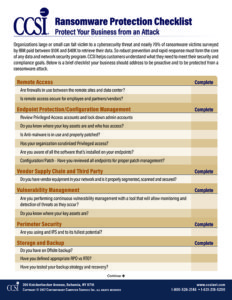Credible Strategies Your Business Can Use to Avoid a Data Breach
Hackers steal data from both large corporations and small businesses. If you look at news stories, you may think that hackers are out to get only the big companies that have an enormous amount of data. What most people don’t realize is that around 90% of data breaches affect small and medium-sized businesses. Without a good cybersecurity plan in place, your company can become a victim of an attack as well.
The negative impact of a data breach on your business can be huge. You can lose a lot of revenue, the reputation of your brand can get damaged, and you can lose your intellectual property. According to a report published by Verizon, it was discovered that hackers managed to break into a system in less than a minute in 93% of data breach cases. Yet it might take your business months to recover from such an attack, if you even manage to get back on your feet.
Every company, no matter how big or small, should carefully implement strategies to protect their data. You can never know if you’re going to be the next victim of a cyber attack, which is why it’s best to be prepared at all times. Here are some of the best strategies your business can use to avoid a data breach.
Train Your Staff
Managers and business owners should be familiar with cybersecurity practices and fully aware of the potential dangers they face from hackers. However, that won’t be enough to protect your company from hacker attacks. You will also need to provide data security training for all of your employees to ensure that your sensitive information doesn’t get stolen. You should organize training at least once a year to give your staff the opportunity to stay up to date on new practices.
You can either train your employees yourself or hire an IT expert to give a short and effective course on data security. If you decide to provide training yourself, you must first instruct your staff how to come up with strong passwords. Encourage each of your employees to set a reminder every few months to change their passwords. Show them how to safely use their computers, laptops, tablets, and smartphones, as well as what to do if they think their device has been hacked.
Make it a policy for all employees to contact someone higher up if they get a suspicious email asking them to share a password or any other type of sensitive information. You should use different types of content to provide cybersecurity training. Videos, infographics, and presentations are a great way to ensure every employee effectively learns how to keep data secure.
Simulate Phishing Attacks
Training your staff is a great way to boost their knowledge about data security, but it doesn’t guarantee they will know how to recognize or respond to an attack. An action as simple as clicking on a link in a malicious email can have devastating consequences for your business, which is why you need to make sure that doesn’t happen.
One of the best way to improve your staff’s readiness for a phishing attack is to simulate one. Don’t let your employees know that you’re planning on simulating an attack. It’s a good idea to wait until a month or two passes after the end of your company’s cybersecurity training before you simulate the attack. There are both free and paid phishing simulators available online that can test your staff’s data security skills. You can also create a simulation with an external team of cybersecurity experts.
Even though everyone knows that you shouldn’t share sensitive information through your email or click on a suspicious link, there is no guarantee that an employee of yours won’t get tricked in a customized phishing attack. Hackers are becoming more skilled each year and base their strategies on human psychology, which is why anyone can be a potential victim of an attack.
Boost Network Security
When your employees learn how to create strong passwords and how often to change them, it will boost your network security. However, that alone won’t be enough to keep your data safe. You should regularly update your operating system, firmware, antivirus, and device drivers. Hackers often target devices with old versions of software because it’s easier to for them to break into.
Another thing you can do is make sure that every device that gets plugged into the network is scanned for malware automatically. If you have an IT department at your company, give them the exclusive privilege to facilitate installations of new software. In other words, prevent regular employees from installing software on their computers. Make a policy that requires employees to get in touch with someone from the IT department every time they want to install a new program. Doing this will minimize the risk of malware attacks.
Aside from implementing strategies that will protect your network from outside attacks, it’s also imperative to stay alert to local threats. You won’t have to worry about a nearby hacker or possibly even an employee of yours stealing your data if you physically secure your network. Lock any doors and cabinets that lead to network infrastructure components.
Perform Vulnerability Assessments
If there are any weak points in your data security plan, you should know about them. You can learn which threats you’re vulnerable to by performing vulnerability assessment. This is a process that helps you identify and analyze potential risks in your computer systems, networks, applications, hardware, and any other types of IT assets.
There are different types of vulnerability assessments you can perform. For instance, you can do a network-based scan to detect the strength of both your wireless and wired networks. Similarly, a host-based scan will let you know if there are any vulnerabilities in any of your network hosts. You can also do database and application scans.
When you perform regular vulnerability assessments, you get a better understanding of your assets, potential security flaws, as well as your overall risk of suffering an attack. Essentially, these assessments will help you stay prepared for any type of attack that could lead to a data breach.
Conclusion
Some hackers are out to get big corporation but others may not be skilled enough to do that, which is why they target small and medium-sized businesses. Don’t think you’re not vulnerable to an attack just because you have a local, small business. If you experience a data breach, you may never recover from it. That’s why you need to implement these strategies and avoid getting your data stolen.
Ransomware Protection Checklist
Ransomware attacks are increasing, but they’re not unstoppable. There is no single layer or control that can be implemented which will completely protect you. Using a layered approach to fight against ransomware and going back-to-basics is the best method to use when defending against attack. Download this checklist for a starting point to protect your organization from the preventable threat of ransomware.

Author Bio: Tobias Foster is a journalist and editor with more than 10 years of work experience in the IT industry. He loves to do programming in his free time as a hobby and teaches basic coding to kids. Tobias enjoys working with young adults, to whom he offers assignment help UK. He works for a few different dissertation writing services to help students excel at their studies. Tobias is known for his masterful custom writing skills and ability to craft perfect essays, which he often offers to students who need Australian assignment help.
Tobias is a guest blogger. All opinions are his own.
The post Credible Strategies Your Business Can Use to Avoid a Data Breach appeared first on CCSI.
*** This is a Security Bloggers Network syndicated blog from CCSI authored by Guest Author. Read the original post at: https://www.ccsinet.com/blog/strategies-avoid-data-breach/





